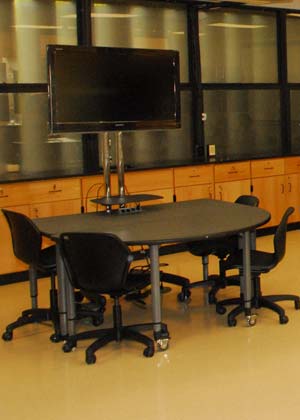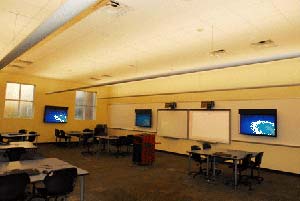21st Century Classrooms | Feature
The Classroom Evolved: Creating an Active Learning Environment
In the first of a new series of articles focused on classroom design, we take a look at a private high school in Florida that's borrowed ideas from two major universities to create classrooms that support interactive, hands-on learning.
- By Bridget McCrea
- 01/25/12
Intent on designing classrooms that would support their school's new active learning initiative, the IT and administrative teams at Bishop Moore Catholic High School in Orlando, FL, tapped into two institutions of higher education for help. Years earlier, North Carolina State University and Massachusetts Institute of Technology were involved in a classroom design project whose concepts melded well with the private high school's active learning plan.
"We did a lot of research and found out that these two universities had designed an ideal active learning space," said Pat LaMorte, director of technology integration for the 1,148-student school. "We modeled our first active learning lab around the concepts developed by MIT and NCSU and then built out from there."
Key decision makers from Bishop Moore also met with architects and designers who had experience in the higher education space. "We wanted to know which models were working at schools around the country," said LaMorte. "After much research and consultation we felt that TEAL was the way to go."

Wheeled for easy mobility--and meant to accommodate a wide range of applications and subjects--Bishop Moore's lab tables are positioned in front of dedicated, wall-mounted, 52-inch monitors with touchscreen capabilities. |
Technology-Enhanced Active Learning
The design for all five of Bishop Moore's active learning classrooms is based on TEAL (Technology-Enhanced Active Learning). According to MIT's Web site the TEAL project was based on the need for a new mix of pedagogy, technology, and classroom design for freshman physics classes. MIT's 3,000-square-foot TEAL classrooms featured an instructor's workstation in the center of the room surrounded by 13 round tables (each seating nine students), 13 whiteboards, and eight video projectors.
Following a similar design philosophy, Bishop Moore built one 1,200-square-foot main lab and four other classrooms that are about 500 square feet in area. The main lab features six tables that accommodate four to five students each. Wheeled for easy mobility--and meant to accommodate a wide range of applications and subjects--the tables are positioned in front of dedicated, wall-mounted, 52-inch monitors with touchscreen capabilities.
LaMorte said the labs were designed with the college learning environment in mind. "Collaboration is the foundation of university learning, and we want to make sure our students are ready for it," said LaMorte. "We knew we had to go beyond the typical 'rows' of desks found in the K-12 space and create a shared, active learning environment."
The room also includes iPad/laptop carts that students can use for individual or group work. Walls double as writing surfaces, according to LaMorte, "and allow students to brainstorm and collaborate in a CSI-like environment." Also incorporated into the space are six microphones and eight speakers that provide even distribution of voices throughout the room.
Upgrading the Infrastructure
Construction of Bishop Moore's active learning labs required significant retrofits of existing classrooms. Electrical and HVAC systems were modified; walls were moved around; wiring was replaced; and power backup systems were installed.
Other key changes included new, flexible classroom furniture and an upgraded campus-wide WiFi system.

Bishop Moore Classroom |
TEAL Classrooms in Action
LaMorte said teachers across all disciplines use the labs. The spaces are extremely popular among faculty members who make reservations to use the state-of-the-art classrooms. "When we put these labs in the hope was that the teachers would be fighting over them," said LaMorte. "It didn't take long for that to happen."
Credit Bishop Moore's determination to put the curriculum first with helping to stoke some of that success. "The labs have helped us change the entire paradigm of education here," said LaMorte. "All teachers are incorporating active learning activities into their classrooms and enabling students to take ownership of their learning."
A 10th-grade English instructor, for example, might kick off the class with a short assignment and/or introductory lesson. Students then break up into small groups to delve more deeply into the day's assignment. Once the collaborative session wraps up, students reconvene as a class and listen to the groups' presentations, get assessed, and receive evaluations from peers and/or the instructor.
"Unlike the traditional classroom setting," said LaMorte, "the teacher really becomes the facilitator in this environment."
Professional development has also played an important role in the labs' success, said LaMorte, whose team handles both the initial and ongoing teacher training. "We're in PD five days a week showing teachers how to use everything in the rooms," said LaMorte, whose team holds workshops for teachers, helps them design lessons, and then provides consistent support throughout the school year. "We help them through all of the frustrations and issues that come up and ensure that everyone has a successful experience."
To other schools looking to either upgrade their existing facilities or start from scratch, LaMorte said the key is to give top priority to the curriculum. Then build the classrooms, labs, or other learning spaces around that foundation.
"Bring in the curriculum initially and then design the space and the technology components around it," said LaMorte. "Ignore this step and you'll end up with a bunch of technology, furniture, and equipment that just sits there unused."
About the Author
Bridget McCrea is a business and technology writer in Clearwater, FL. She can be reached at [email protected].